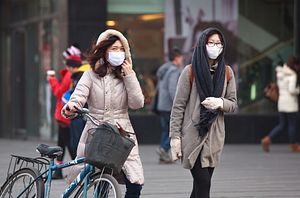“APEC Blue,” a term that emerged this week to describe the ephemeral skies above Beijing just before the APEC summit, vividly depicts the façade that China wanted to present to the world while it hosted the 21 heads of the Asia-Pacific economies. It also brings to mind the 2008 Beijing Olympics, when the sky was a clear blue and just a handful of cars ran down empty streets amid shuttered factories in Beijing and its neighboring provinces. Beijing once again showed itself willing to spend time, energy, money, and propaganda resources to impress the world with its ability to show its very best face.
Beijing not only spent $6 billion on a lakeside campus 40 miles outside Beijing, accessed by a new elevated expressway leading to the 595-room hotel, conference hall, and press center; it also took half of the cars off local roads, closed more than 1,000 heavy industrial plants within a 120-mile radius of the city, and delayed central heating services in Tianjin until the summit was over. Together with students, public sector employees enjoyed one week off during the summit. In addition, no passports were issued, no weddings were registered, no taxes were paid, no fresh products were delivered, and no banks were open. Apparently burial services were even partially suspended during APEC.
And the cost of this all-out push? Due to factory shutdowns in Beijing, Tianjin, and five provinces subject to the APEC restrictions; Barclays and Beijing-based investment firm First Capital said heavy industry suffered significantly. It is hard to calculate the exact economic impact of “APEC Blue,” but comparing it to the Beijing Olympic Games in 2008 may provide a reasonable estimate of the potential costs of the summit. By shutting down or restricting production at heavy polluters within a 500 km radius from June to October 2008, including Hebei and Inner Mongolia, light industrial production fell from 13.3 to 10.3 percent, while heavy industry fell from 17.1 to 7.3 percent year on year.
What measures did the government take to guarantee APEC Blue? By sending out 16 teams covering Beijing and Tianjin municipalities, as well as Hebei, Shandong, Shanxi, Henan and Inner Mongolia, the Ministry of Environmental Protection together with local governments investigated and punished 24 government officials for violating related regulations. Individuals at five companies were fined 350,000 RMB ($57,123).
Although they enjoyed the clear air, the people of Beijing have their doubts about the quick-fix model of draconian measures to improve the air quality for special occasions. It is inconvenient for locals to suspend or diminish vital public services. The partial car ban meant that public transport was even more packed than normal, which indirectly caused a young girl’s death on an overcrowded platform. People also complained that while the government is capable of creating an APEC Blue with short-term administrative measures, it is as yet incapable of longer-term fixes to pollution. The term “APEC Blue” itself, coined by Chinese netizens, is revealing of the skepticism.
In response, CCP-affiliated media drew “precious lessons” from APEC Blue on how to reduce air pollution in the future. The Chinese government is well aware of public discontent over the persistent smog in its capital city. Since the 2008 Beijing Olympics, local authorities have announced a clutch of new laws and regulations, which have increased fines and punishments for environmental violations, expanded public transportation by adding 10 more subway lines, and shut down high carbon emission factories.
More is planned, with China Daily reporting that Beijing intends to “phase out around 1 million vehicles with low emissions standards”; although when and how has yet to be decided. Residents of Beijing will no doubt be hoping for more policies like this one, to make the clear air of “APEC Blue” a daily reality.
Stella Ran Zheng is a graduate student from Elliott School of International Affairs at George Washington University.

































